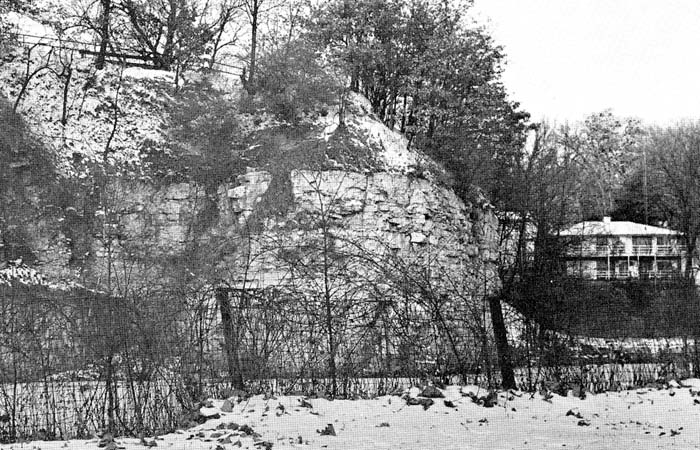
By
Bob Hibbs
The
Hutchinson Quarry in the bluff along North Riverside Drive provided foundation
and basement wall stone for early local buildings, then settled into the
scenic landscape for a century before being chosen as ground zero for a $21
million University of Iowa Art Annex building currently under construction.
The
quarried limestone bluff will provide a picturesque backdrop when viewed from
within the new structure while still serving the passerby.
Owned
originally by Iowa City pioneer Robert Hutchinson, the quarry was worked from
the 1840s through about 1900. However, like “Public Quarry” located in the
opposite river bluff downhill from what is now the University of Iowa
President’s House, it produced stone best suited for unseen masonry.
It
was worked principally with hand picks and wheelbarrows, producing irregular,
broken stones.
This
bedrock is loaded with fossilized corals in sufficiently large numbers to make
the formation noteworthy among geologists worldwide. Samples are said to have
dazzled curators at the British Museum in London when presented by early Iowa
promoter John Newhall, who authored “A Glimpse of Iowa in 1846.”
After
the first steamboat arrived at “The Port of Iowa City” in 1841, Newhall
had served as the keynote speaker for a festive banquet at Swan’s Hotel
located on the site now serving Gilmore Hall. The hotel was operated by city
founder Chauncey Swan and his wife, Dolly.
In
1866 eminent Harvard Prof. Louis Agassiz came to wonder over the local
fossil-bearing rock. He developed a lecture titled “The Coral Reefs of Iowa
City,” a sensation in its day. Local craftsmen fashioned the so-called
bird-eye marble into cane heads and nick-knacks since the stone polished well.
Even
a tiny village upstream from Iowa City took its name from the noted corals;
thus, Coralville.
At
Hutchinson Quarry, UI professor and distinguished geologist Samuel Calvin
found a crew of from six to eight men working during the 1890s. It had been
opened not long after 1843 when Hutchinson purchased an Iowa Territory-owned
tract west of the river considered too remote from town to be of much value.
There
were no bridges then, just ferries operating intermittently. Parts of the
tract also were a wetland, now drained and filled to serve the Art, Art
Museum, Theatre and Music buildings, as well as Hancher Auditorium.
On
higher ground on his tract, Hutchinson, a carpenter from New Hampshire who
specialized in building window sashes and doors, soon built a one-story stone
dwelling now located along Park Road and serving University of Iowa Press. He
reportedly used stone rejected for use in Old Capitol.
The
house has since had dormers and a second floor added, as well as undergoing
extensive subsequent renovation to serve modern offices.
Hutchinson
also is credited with helping build the 1850 Presbyterian Church predecessor
to Old Brick, as well as the 1842 Mechanics Academy building along North Linn
Street where the university eventually would be housed during its nascent
years before inheriting Old Capitol when state government was moved to Des
Moines in 1857.
The
Hutchinson Quarry is one of a half-dozen stone bearing sites along the river
in central Iowa City. The most northerly is at UI’s Mayflower Residence Hall
along North Dubuque Street, with others downriver as far as the cliffs along
South Riverside Drive opposite UI’s Hydraulics Laboratory near the
Burlington Street intersection.
A
well located old quarry site is still identifiable along what is now Kimball
Road at North Dubuque Street below the Bella Vista Heights neighborhood. Its
pit has been filled, now serving as a level lawn.
Although
Happy Hollow Park along Brown Street at North Governor Street often is
supposed to have been a quarry site, it’s actually a clay pit that served
brick manufacturing.
Such,
with sidelights, is a brief history of Hutchinson Quarry. Next
Saturday:
Triumph and tragedy of Iowa City’s Close family. Bob Hibbs collects local postcards and researches history related to them.
|